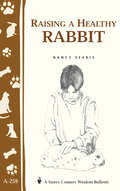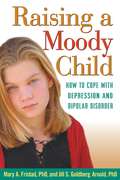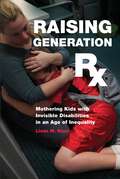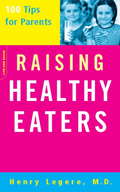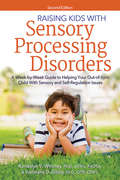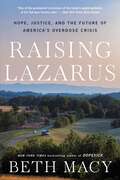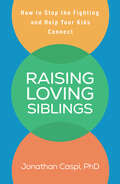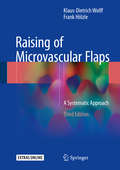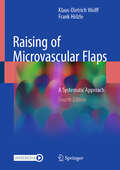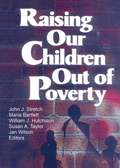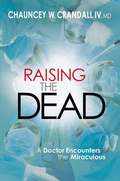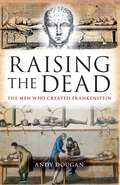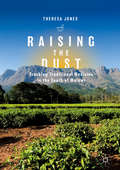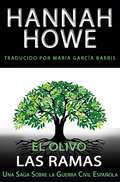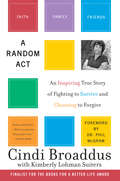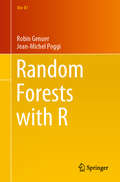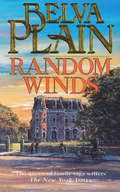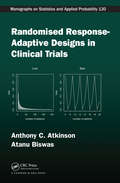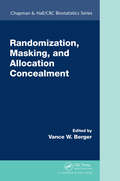- Table View
- List View
Raise Your Vibes!: Energy Self-healing For Everyone
by Athena BahriA fun and super-practical guide to getting healthier and happier by tapping into the incredible power of energy healing. The author is a qualified Reiki Master with a mission to make the healing power of Reiki, and energy healing in general, accessible to all.Fun and easy to use, this book enables everyone to take advantage of the healing and empowering energies gifted to us by the Universe, and to take their wellbeing into their own hands. Reiki Master Athena Bahri has developed an approach to energy self-healing that combines simple Reiki techniques that anyone can use with a range of different healing modalities, from crystals to lunar rituals. The book is aimed at all those people who are looking for ways of improving their lives that aren't too complicated and can be done without spending time and money on expensive courses. It includes a straightforward process of Reiki self-attunement that will enable readers to access the simple Reiki healing powers and combine these with the other techniques described. The emphasis is on empowering readers to use these tools to create a vibration-raising practice of their own, that they can then use in a range of different situations, from dealing with physical pain to ridding themselves of stress and lingering emotional upset to improving the vibes of their surroundings at work and at home.
Raising a Healthy Guinea Pig: Storey's Country Wisdom Bulletin A-173 (Storey Country Wisdom Bulletin Ser.)
by Wanda L. CurranSince 1973, Storey's Country Wisdom Bulletins have offered practical, hands-on instructions designed to help readers master dozens of country living skills quickly and easily. There are now more than 170 titles in this series, and their remarkable popularity reflects the common desire of country and city dwellers alike to cultivate personal independence in everyday life.
Raising a Healthy Rabbit: Storey's Country Wisdom Bulletin A-259 (Storey Country Wisdom Bulletin Ser.)
by Nancy SearleRaise your rabbit the right way!Friendly and easy to care for, rabbits make ideal family pets. But how do you keep a pet rabbit happy and healthy? How can you tell if your rabbit is sick? What would you do if it were?Raising a Healthy Rabbit explains all the essentials of caring for a rabbit, including choosing a rabbit for adoption, the proper way to pick up and carry a rabbit, and setting up the best housing. It also includes vital information on supplying proper nutrition (including when, what, and how much to feed your pet); performing daily, weekly, and monthly health care checks; recognizing and treating common health problems; and stocking a rabbit first-aid kit.
Raising a Moody Child
by Mary S. Arnold Mary A. FristadEvery day can be an ordeal for families struggling with the difficult, moody, "impossible" behavior that may point to childhood depression or bipolar disorder. Effective help for kids does exist, but it often requires a customized combination of medication, therapy, coping skills, and support. From esteemed clinician and researcher Dr. Mary Fristad and fellow treatment expert Dr. Jill Goldberg Arnold, this indispensable book explains how treatment works and what additional steps parents can take at home to help children with mood disorders--and the family as a whole--improve the quality of their lives. Explained are why symptoms look so different (and can be so much harder to manage) in children and teens than in adults, how to find the right doctor or therapist, and how to help kids develop their own "coping toolkits." Bursting with practical tools, FAQs, and examples, the book covers everything from dealing with medical crises to resolving school problems, sibling conflicts, and marital stress.
Raising Generation Rx: Mothering Kids with Invisible Disabilities in an Age of Inequality
by Linda M. BlumWinner, 2016 Outstanding Publication in the Sociology of Disability, American Sociological Association, Section Disability and SocietyExamines the experiences of mothers coping with their children’s “invisible disabilities” in the face of daunting social, economic, and political realitiesRecent years have seen an explosion in the number of children diagnosed with “invisible disabilities” such as ADHD, mood and conduct disorders, and high-functioning autism spectrum disorders. Whether they are viewed as biological problems in brain wiring or as results of the increasing medicalization of childhood, the burden of dealing with the day-to-day trials and complex medical and educational decisions falls almost entirely on mothers. Yet few ask how these mothers make sense of their children’s troubles, and to what extent they feel responsibility or blame. Raising Generation Rx offers a groundbreaking study that situates mothers’ experiences within an age of neuroscientific breakthrough, a high-stakes knowledge-based economy, cutbacks in public services and decent jobs, and increased global competition and racialized class and gender inequality. Through in-depth interviews, observations of parents’ meetings, and analyses of popular advice, Linda Blum examines the experiences of diverse mothers coping with the challenges of their children’s “invisible disabilities” in the face of daunting social, economic, and political realities. She reveals how mothers in widely varied households learn to advocate for their children in the dense bureaucracies of the educational and medical systems; wrestle with anguishing decisions about the use of psychoactive medications; and live with the inescapable blame and stigma in their communities.
Raising Healthy Eaters: 100 Tips For Parents
by Henry LegereFrom a pediatrician who specializes in childhood obesity, 100 healthy eating tips for parents of children of all ages.
Raising Kids With Sensory Processing Disorders: A Week-by-Week Guide to Helping Your Out-of-Sync Child With Sensory and Self-Regulation Issues
by Rondalyn Whitney Varleisha GibbsTaking a look at the most common sensory issues kids face, Raising Kids With Sensory Processing Disorders offers a compilation of unique, proven strategies that parents can implement to help their children move beyond their sensory needs. This updated second edition:Shows parents how to characterize their child's sensory issues into one of several profiles.Helps parents find the best adaptations and changes to their child's everyday routines.Provides a week-by-week series of activities and checklists.Helps improve children's performance on tasks like homework, transitions between activities, and interactions with friends.Is written by parents and occupational therapists.Whether it's having to remove tags from clothing or using special dimmed lighting when they study, kids with sensory disorders or special sensory needs often need adaptations in their everyday lives in order to find success in school and beyond.
Raising Lazarus: Hope, Justice, and the Future of America's Overdose Crisis
by Beth MacyA &“deeply reported, deeply moving&” (Patrick Radden Keefe) account of everyday heroes fighting on the front lines of the overdose crisis, from the New York Times bestselling author of Dopesick (inspiration for the Peabody Award-winning Hulu limited series) and Factory Man. Nearly a decade into the second wave of America's overdose crisis, pharmaceutical companies have yet to answer for the harms they created. As pending court battles against opioid makers, distributors, and retailers drag on, addiction rates have soared to record-breaking levels during the COVID pandemic, illustrating the critical need for leadership, urgency, and change. Meanwhile, there is scant consensus between law enforcement and medical leaders, nor an understanding of how to truly scale the programs that are out there, working at the ragged edge of capacity and actually saving lives. Distilling this massive, unprecedented national health crisis down to its character-driven emotional core as only she can, Beth Macy takes us into the country&’s hardest hit places to witness the devastating personal costs that one-third of America's families are now being forced to shoulder. Here we meet the ordinary people fighting for the least of us with the fewest resources, from harm reductionists risking arrest to bring lifesaving care to the homeless and addicted to the activists and bereaved families pushing to hold Purdue and the Sackler family accountable. These heroes come from all walks of life; what they have in common is an up-close and personal understanding of addiction that refuses to stigmatize—and therefore abandon—people who use drugs, as big pharma execs and many politicians are all too ready to do. Like the treatment innovators she profiles, Beth Macy meets the opioid crisis where it is—not where we think it should be or wish it was. Bearing witness with clear eyes, intrepid curiosity, and unfailing empathy, she brings us the crucial next installment in the story of the defining disaster of our era, one that touches every single one of us, whether directly or indirectly. A complex story of public health, big pharma, dark money, politics, race, and class that is by turns harrowing and heartening, infuriating and inspiring, Raising Lazarus is a must-read for all Americans.
Raising Loving Siblings: How to Stop the Fighting and Help Your Kids Connect
by Jonathan Caspi&“Be nice to your sister!&” &“Stop picking on your brother!&” &“That's a time-out for both of you." When nothing works to stop the incessant battles, where can exhausted parents turn? Sibling expert and family therapist Jonathan Caspi knows that understanding why kids fight is the first essential step to restoring peace. Featuring clear principles, dos and don'ts, and loads of stories, this book shines a spotlight on family dynamics. Dr. Caspi guides you to make an effective plan for managing conflicts, so you can keep a cool head in the heat of the moment. Learn why it's never helpful to compare kids to each other, how to quell sibling struggles without taking sides, when to intervene (and when to step back), and what to do when parents aren't on the same page. Improving sibling relationships can have lifelong benefits for your family. This compassionate book shows how.
Raising of Microvascular Flaps: A Systematic Approach
by Frank Hölzle Klaus-Dietrich Wolff- Clearly illustrated with over 112 color illustrations to show all aspects of surgeries.
Raising of Microvascular Flaps: A Systematic Approach
by Frank Hölzle Klaus-Dietrich WolffThis book serves as a comprehensive resource for everyone involved in microsurgical tissue transfer, including plastic surgeons, ENT surgeons, oral and maxillofacial surgeons, and trauma surgeons, equipping them with essential knowledge for daily practice. The new fourth edition builds on the didactic approach of breaking down complex surgical procedures into a sequence of simple, manageable steps, guided by clearly defined landmarks specific to each donor site. For each flap, an anatomically guided, step-by-step approach is presented, prioritizing simplicity, safety, and reliability to ensure successful flap harvesting. Each step is illustrated with photographs complemented by detailed schematic color drawings, providing a clear understanding of the anatomy. Supplementary online videos provide detailed demonstrations of the surgical techniques. This edition also introduces the elevation of the ulnar forearm flap and includes a new chapter on the gracilis free flap, a dependable option for motor reinnervation in cases of facial paralysis. This fourth edition also includes two additional perforator flaps: the thoracodorsal artery perforator flap and the medial femoral condyle bone flap. The latter serves as an excellent donor site for craniofacial bony defects and has been specifically proposed for use in jaw reconstruction within the oral cavity. As with previous editions, the book serves as a concise and focused resource, providing invaluable information for any reconstructive surgeon.
Raising Our Children Out of Poverty
by Jan Wilson William J Hutchison John J Stretch Maria Bartlett Susan A TaylorRaising Our Children Out of Poverty shows what can be done at the national and local community levels to raise children out of poverty by strengthening families, communities, and social services. br>Based on the April 1998 symposium “Raising Our Children Out of Poverty” at the Saint Louis University School of Social Service, this important book is particularly timely given the prevalence of poverty among children in the United States. Social Work practitioners and other helping advocates will discover chapters discussing the future of foster care, ecumenical housing, collaborative practice in low income communities, fostering resiliency in children, programs that are alternatives to incarceration, and an innovative family support and empowerment program. This important book will help you provide improved services to families and children living in poverty.
Raising the Dead: A Doctor Encounters the Miraculous
by Chauncey W. CrandallOn October 20, 2006, a middle-aged auto mechanic, Jeff Markin, walked into the emergency room at the Palm Beach Gardens Hospital and collapsed from a massive heart attack. Forty minutes later he was declared dead. After filling out his final report, the supervising cardiologist, Dr. Chauncey Crandall, started out of the room. "Before I crossed its threshold, however, I sensed God was telling me to turn around and pray for the patient," Crandall explained. With that prayer and Dr. Crandall's instruction to give the man what seemed one more useless shock from the defibrillator, Jeff Markin came back to life--and remains alive and well today. But how did a Yale-educated cardiologist whose Palm Beach practice includes some of the most powerful people in American society, including several billionaires, come to believe in supernatural healing? The answers to these questions compose a story and a spiritual journey that transformed Chauncey Crandall. Dr. Crandall wrote that ". . . the Lord said clearly to me, 'I've called you to be a physician. . . . I've given you a platform as a physician to win the lost for Christ. You will take this platform and have influence over people, wherever you go, based on your testimony.' I finally understood that many people would find my testimony credible precisely because I was a physician rather than a professional minister." Because of Dr. Crandall's encounters with the miraculous, he presently wants to heal both people's bodies and souls instead of just trying to advance himself in the medical world and earn more money like he did in the past before his remarkable metamorphosis.
Raising the Dead: The Men Who Created Frankenstein
by Andy DouganA &“pleasingly ghoulish&” look at the real-life Dr. Frankensteins of the nineteenth century and their legacy in modern medicine (Telegraph). Mary Shelley's 1818 novel, Frankenstein, introduced readers to the concept of raising the dead through scientific procedures. Those who read the book were thrilled by this incredible Gothic adventure. Few, however, realized that Shelley&’s story had a basis in fact. Her modern Prometheus was a serious pursuit for some of the greatest minds of the early nineteenth century. It was a time when scientists genuinely believed, as Frankenstein did, that they could know what it feels like to be God. Raising the Dead is the story of the science of galvanism—named after the Italian scientist Luigi Galvani, who had conducted the original experiments—a movement that investigated the theory of &“animal electricity,&” a unifying vital spirit that animates us all, with leaders who believed that they stood on the brink of immortality. While they ultimately failed in this challenge, their studies mapped out the nervous system and made valuable and enduring contributions to medical knowledge and understanding—from theorizing the concepts of the modern-day defibrillator to the use of deep brain stimulus to treat personality disorders to experimental procedures using microchip-controlled devices to bridge damaged spinal nerves. This &“excellent, highly readable history&” tells their stories (Herald).
Raising the Dead
by Richard SelzerThe fragility of health and robustness of imagination merge when a seemingly healthy man's legs collapse suddenly beneath him, propelling him into a 23-day coma triggered by Legionnaire's Disease. Here, Selzer relives his illnesses, allowing the reader a highly personal glimpse into his delirium as he skates the line between life and death. This tale of survival remains unsentimental as Selzer grounds what was surely a terrifying experience in humour, emphasised by use of third person narrative.
Raising the Dust: Tracking Traditional Medicine In The South Of Malawi
by Theresa JonesRaising the Dust explores the relationship between human and ecological health through the lens of African traditional medicine, as practiced in the south of Malawi. The book employs an ethnographic methodology using the primary methods of semi-structured interviews and participant observation. The fieldwork for the research was conducted in the Mulanje Mountain Biosphere and the findings are presented as a narrative exploration of insider and outsider positions, in this context. The conceptual framework for the book encompasses a broad range of ecological ideas, focussing mainly on traditional ecological knowledge and radical ecology. The holistic theoretical framework for the book emerges in a grounded way from out of the fieldwork experience. The book is written in plain language and will appeal to anyone interested in holistic health outlooks, particularly cross-cultural health and wellbeing narratives.
Raising the Living Dead: Rehabilitative Corrections in Puerto Rico and the Caribbean
by Alberto Ortiz DíazAn eye-opening look at how incarcerated people, health professionals, and others behind and beyond bars came together to problem-solve incarceration. Raising the Living Dead is a history of Puerto Rico’s carceral rehabilitation system that brings to life the interactions of incarcerated people, their wider social networks, and health care professionals. Alberto Ortiz Díaz describes the ways that multiple communities of care came together both inside and outside of prisons to imagine and enact solution-oriented cultures of rehabilitation from the 1930s to the 1960s. Scientific and humanistic approaches to well-being were deliberately fused to raise the “living dead,” an expression that reemerged in the modern Caribbean to refer to prisoners. These reform groups sought to raise incarcerated people physically, mentally, socially, spiritually, and civically. The book is based on deep, original archival research into the Oso Blanco (White Bear) penitentiary in Puerto Rico, yet it situates its study within Puerto Rico’s broader carceral archipelago and other Caribbean prisons. The agents of this history include not only physical health professionals, but also psychologists and psychiatrists, social workers, spiritual and religious practitioners, and, of course, the prisoners and their families. By following all these groups and emphasizing the interpersonal exercise of power, Ortiz Díaz tells a story that goes beyond debates about structural and social control. The book addresses key issues in the history of prisons and the histories of medicine and belief, including how prisoners’ different racial, class, and cultural identities shaped their incarceration and how professionals living in a colonial society dealt with the challenge of rehabilitating prisoners for citizenship. Raising the Living Dead is not just about convicts, their immediate interlocutors, and their contexts, however, but about how together these open a window into the history of social uplift projects within the (neo)colonial societies of the Caribbean. There is no book like this in Caribbean historiography; few examine these themes in the larger literature on the history of prisons.
Ralph Edwards: The Inside Story of a Worldwide Quest for Safer Medicines (Springer Biographies)
by Ian HembrowMedical treatments designed to help people can also be harmful or fatal. Around 2.5 million people die this way each year. So if any kind of medicine makes someone unwell, they or their doctor should report it. Those reports, from nearly every country in the world, go to the Uppsala Monitoring Centre (UMC) in Sweden. As the Centre’s first director, Professor Ivor Ralph Edwards transformed it from a tiny operation with limited horizons into an internationally acclaimed scientific organization at the heart of the World Health Organization’s Programme for International Drug Monitoring. He was then succeeded by his wife, Dr Marie Lindquist.This is the story of how a new science developed and a passionate and dedicated pursuit of worldwide medicines safety, with an unerring focus on the welfare of patients. The pioneering work of Ralph, Marie and their collaborators on every continent protected the lives of millions of people. It may yet improve the lives of billions more.
Las Ramas: El Olivo
by Hannah HoweLa joven enfermera Heini Hopkins viaja a través de Francia hacia España donde espera descubrir el destino de su novio, Deiniol Price, voluntario en las Brigadas Internacionales. Espera ser enfermera de las tropas Legalistas que luchan contra el fascismo en la Guerra Civil española. En un viaje parecido, pero sin conexión alguna, la novelista Naomí Parker viaja a España donde pretende escribir notas de propaganda en favor de los fascistas. También desea encontrarse con el hombre de sus sueños, el apuesto piloto, Príncipe Nicolás Esteban. Mientas Naomí disfruta de la vida acomodada en España, Heini va a parar a la línea del frente donde atiende a un incontable número de heridos. Los Legalistas se preparan para el combate con palos en lugar de armas mientras los fascistas les bombardean desde aviones alemanes. En esas circunstancias tan desiguales, ¿cómo puede sobrevivir Deiniol? Además, ¿cómo puede Heini mantenerse fiel a sí misma entre todo ese caos? MIentras busca las respuestas, Heini aprende a conocerse as í misma así como duras lecciones sobre el amor y la guerra.
A Random: An Inspiring True Story of Fighting to Survive and Choosing to Forgive
by Cindi Broaddus Kimberly Lohman SuitersCindi Broaddus didn't realize that her life was about to be forever altered as she sat in the passenger seat of a car on a lonely highway, speeding toward the airport in the early morning hours of June 5, 2001. A single mother of three and a delighted new grandmother, she was thinking only of her well-earned vacation when a gallon jar of sulfuric acid, tossed from an overpass by an unknown assailant, came crashing through the windshield. In a heartbeat, Cindi was showered with glass and flesh-eating liquid, leaving her screaming in agony and burned almost beyond recognition.A Random Act is the riveting firsthand account of a brutal and senseless attack and its aftermath. Much more than one remarkable woman's chronicle of an unthinkable tragedy and amazing recovery, Cindi's story is one of hope and transcendence, born of a conscious and dedicated determination to turn a nightmarish experience into something positive and uplifting. Her unforgettable journey back to life and a gloriously renewed sense of purpose offers illuminating truths about love, healing, and the astounding power of choice.
Random Forests with R (Use R!)
by Robin Genuer Jean-Michel PoggiThis book offers an application-oriented guide to random forests: a statistical learning method extensively used in many fields of application, thanks to its excellent predictive performance, but also to its flexibility, which places few restrictions on the nature of the data used. Indeed, random forests can be adapted to both supervised classification problems and regression problems. In addition, they allow us to consider qualitative and quantitative explanatory variables together, without pre-processing. Moreover, they can be used to process standard data for which the number of observations is higher than the number of variables, while also performing very well in the high dimensional case, where the number of variables is quite large in comparison to the number of observations. Consequently, they are now among the preferred methods in the toolbox of statisticians and data scientists. The book is primarily intended for students in academic fields such as statistical education, but also for practitioners in statistics and machine learning. A scientific undergraduate degree is quite sufficient to take full advantage of the concepts, methods, and tools discussed. In terms of computer science skills, little background knowledge is required, though an introduction to the R language is recommended. Random forests are part of the family of tree-based methods; accordingly, after an introductory chapter, Chapter 2 presents CART trees. The next three chapters are devoted to random forests. They focus on their presentation (Chapter 3), on the variable importance tool (Chapter 4), and on the variable selection problem (Chapter 5), respectively. After discussing the concepts and methods, we illustrate their implementation on a running example. Then, various complements are provided before examining additional examples. Throughout the book, each result is given together with the code (in R) that can be used to reproduce it. Thus, the book offers readers essential information and concepts, together with examples and the software tools needed to analyse data using random forests.
Random Winds
by Belva PlainFrom a quiet turn-of-the-century village in upstate New York to war-torn London, from the bedsides of the rural poor to the life-and-death urgency of a New York hospital, comes a powerful epic of three generations of doctors in one family. The Farrell family are dedicated, brilliant... and driven to the edge of destruction by a love no force can suppress.
Randomised Clinical Trials: Design, Practice and Reporting
by David Machin Peter M. Fayers Bee Choo TaiRandomised Clinical Trials: Design, Practice and Reporting provides a detailed overview of the methodology for conducting clinical trials, including developing protocols, data capture, randomisation, analysis and reporting. Assuming no prior background, this user-friendly resource describes the statistical, regulatory, and practical components required for conducting randomised clinical trials. Numerous examples and case studies from industry, academia, and the research literature help readers understand each stage of the clinical trial process. This second edition contains extensively revised material throughout, including new chapters covering designs for repeated measures, non-inferiority, cluster and stepped wedge trials. Other new chapters describe data and safety monitoring, biomarker studies, and feasibility studies. Updated and expanded sections discuss situations where multiple organs, different body locations or competing risks are involved, subgroup analysis, and multiple outcomes. Written by an author team with extensive experience in conducting clinical trials, this book: Provides comprehensive coverage of randomised clinical trials, ranging from basic to advanced Features several new chapters, updated case studies and examples, and references to changes in regulations Explains basic randomised trials, including the parallel two-group controlled trial with a single outcome measure Covers paired trial designs and trials with more than two interventions Includes a chapter on miscellaneous topics such as adaptive designs, large simple trials, Bayesian methods for very small trials, alpha-spending functions and the predictive probability test Randomised Clinical Trials is essential reading for clinicians, nurses, data managers, and medical statisticians involved in clinical trials, and for health practitioners responsible for direct patient care in a clinical trial setting.
Randomised Response-Adaptive Designs in Clinical Trials
by Anthony C Atkinson Atanu BiswasRandomised Response-Adaptive Designs in Clinical Trials presents methods for the randomised allocation of treatments to patients in sequential clinical trials. Emphasizing the practical application of clinical trial designs, the book is designed for medical and applied statisticians, clinicians, and statisticians in training. After introducing clin
Randomization, Masking, and Allocation Concealment (Chapman & Hall/CRC Biostatistics Series)
by Vance BergerRandomization, Masking, and Allocation Concealment is indispensable for any trial researcher who wants to use state of the art randomization methods, and also wants to be able to describe these methods correctly. <P><P>Far too often the subtle nuances that distinguish proper randomization from flawed randomization are completely ignored in trial reports that state only that randomization was used, with no additional information. Experience has shown that in many cases, the type of randomization that was used was flawed. It is only a matter of time before medical journals and regulatory agencies come to realize that we can no longer rely on (or publish) flawed trials, and that flawed randomization in and of itself disqualifies a trial from being robust or high quality, even if that trial is of high quality otherwise. <P><P>This book will help to clarify the role randomization plays in ensuring internal validity, and in drawing valid inferences from the data. The various chapters cover a variety of randomization methods, and are not limited to the most common (and most flawed) ones. Readers will come away with a profound understanding of what constitutes a valid randomization procedure, so that they can distinguish the valid from the flawed among not only existing methods but also methods yet to be developed.


